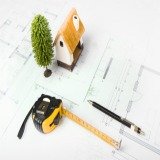What Are The Steps To Build A Home?
The steps to build a home are basic building blocks of knowledge you can use to bring that dream home to fruition!
Have you thought and dreamed of one day building your own home? I'm going to assume the answer is yes because you're here reading this site. Naturally, your next question would be:
What are the steps to build a home?
Well dear reader, you have come to the right place! A custom home project has different variations and phases but usually follows in a step by step process.
The following list will explain how to build a house.....
Let's begin!
Steps to build a home:
- Make your decision with plans to build a home
- Learn how to make a budget and organize your finances
- Select the parcel of land that you want to make an offer
- Find out if the parcel can tap into county water and sewage and at what cost?
- If you can't get county water and sewage from the parcel, you will need the owner of the land to provide you with documentation (A perc test ) of whether the soil will absorb the discharge of a septic system
- If the owner can provide you documentation, make your offer
-
View my vacant land financing page for vital information that will save you money!
- Obtain land financing (not easy in uncertain economic times) unless you are paying cash
- Purchase the Land
- Choose the home floor plans that fulfill your wildest desires! (within your price range, of course!)
- Hire a local architect to review your plans to build a home to make sure you can get building permit approval
- Interview and select your general contractor (unless you plan on being your own GC)
- Submit your architect reviewed plans to build a home to your county building department for permit approvals
- Search around for the best construction loan rates and apply for a construction loan
- Pick up your building permits from the county and pay all required permit fees
- Secure and finalize your construction loan financing
- Once approved, your lender will order a prospective (future value) appraisal, get a copy for your records (this will help better determine your budget)
- Hire a state registered surveyor to stake (set boundaries) your lot. Having a survey done is really important. You need to know what setbacks and restrictions your county has placed on your lot. It's better to have a professional surveyor handle this for you. It's not pretty to have to rip down your concrete foundation and start over because you violated a county setback restriction. If you build it according to your surveyors boundaries and violate restrictions, the survey company is liable for your foundation removal (a costly expense)
- Excavate (clear) your land to make it a buildable lot. This requires heavy machinery to dig large holes in the site for your foundation. Your general contractor should take care of this process for you. However you should communicate with your GC to let them know what portions of the scenery you would like to preserve
- Prepare and hook up utilities. This includes water (public or well, if public water isn't available in your area), sewer (public or septic tank), electric (or gas)
- Set up your footings and trenches at the base of the foundation
- Pour your concrete foundation into the trenches. The foundation must be built several feet below grade (the furtherest depth that land will freeze) in cold climates. If your home will have a basement, your foundation will be dug at least 8 feet deep
- Add rough exterior framing
- Install the roof
- Install windows
- Install exterior doors
- Add rough interior framing
- Install fireplaces
- Install the HVAC system
- Install rough-in plumbing
- Install electrical and mechanical
- Apply insulation to the interior walls. Also, some counties require an inspection from the building department when insulation is installed before drywall can be put up
- Add interior drywall and ceiling finish
- Add exterior siding, stucco, brick veneer, or stone
- Add cabinets, interior doors, and moldings
- Install the tile and counters
- Apply interior paint
- Install plumbing and electrical fixtures
- Lay the flooring down for the rest of the home
- Install appliances and finish last minute carpentry
- Request a final inspection from the county
- Obtain your certificate of occupancy
- Convert your construction loan to permanent financing
- Style your landscaping, including exterior additons (ex. deck)
- Enjoy Your New Home!
Here is a condensed version of the steps to build a home:
% of Completion per phase of how to build a house
10% Foundation, basement, or concrete slab and utility hookup
20% Rough framing
30% Roof decking
40% Roof cover, windows, and exterior doors
50% Insulation, rough in plumbing, electrical and mechanical
60% Exterior wall cover OR interior drywall and ceiling finish
70% Exterior wall cover AND interior drywall and ceiling finish
80% Cabinets, interior doors and trim
90% Painting and plumbing fixtures
100% Floor cover, appliances, light fixtures, and finish hardware
I hope this list gave you a comprehensive view of the steps to build a home. To return to the home building plans page or home page click below.
You Might Also Like:
Home Design Floor PlansHome Design Floor Plans |
Green Home DesignsGreen Home Design |
Boat Home PlansBoat Houses |












